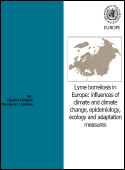Lyme borreliosis in Europe. Influences of climate and climate change, epidemiology, ecology and adaptation measures

Download
By Elisabet Lindgren and Thomas G.T. Jaenson
2006, 34 pages
ISBN 92 890 2291 4
This publication is only available online.
This publication reviews the impacts of climate change on Lyme borreliosis in Europe. Although it is treatable with antibiotics, it is the most common vector-borne disease in the Region and may lead to severe complications of the neurological system, the heart, and the joints. It is caused by a spirochete, which is transmitted to humans by ticks whose reservoir animals are small rodents, insectivores, hares and birds.
Ticks are highly sensitive to changes in seasonal climate. Since the 1980s, tick vectors have increased in density and spread into higher latitudes and altitudes in Europe. Future climate change in Europe is therefore likely to facilitate the spread of Lyme borreliosis in the same way, while reducing its occurrence in areas that become hotter and drier.
To counteract this threat, preventive measures such as information for the general public, surveillance activities and standardized methods of collecting data all need to be strengthened.



